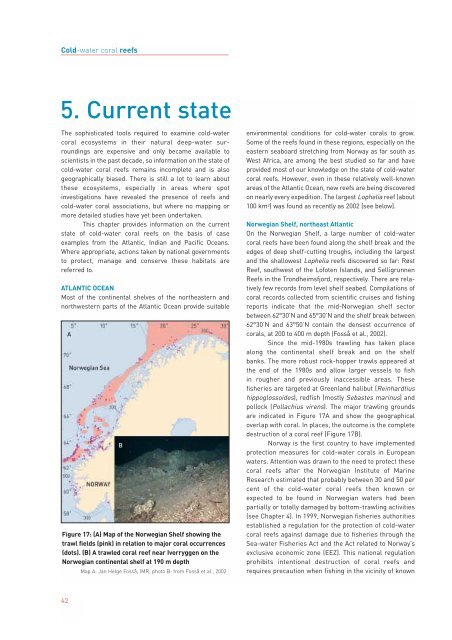Cold-water coral reefs - WWF UK
Cold-water coral reefs - WWF UK
Cold-water coral reefs - WWF UK
You also want an ePaper? Increase the reach of your titles
YUMPU automatically turns print PDFs into web optimized ePapers that Google loves.
<strong>Cold</strong>-<strong>water</strong> <strong>coral</strong> <strong>reefs</strong><br />
5. Current state<br />
The sophisticated tools required to examine cold-<strong>water</strong><br />
<strong>coral</strong> ecosystems in their natural deep-<strong>water</strong> surroundings<br />
are expensive and only became available to<br />
scientists in the past decade, so information on the state of<br />
cold-<strong>water</strong> <strong>coral</strong> <strong>reefs</strong> remains incomplete and is also<br />
geographically biased. There is still a lot to learn about<br />
these ecosystems, especially in areas where spot<br />
investigations have revealed the presence of <strong>reefs</strong> and<br />
cold-<strong>water</strong> <strong>coral</strong> associations, but where no mapping or<br />
more detailed studies have yet been undertaken.<br />
This chapter provides information on the current<br />
state of cold-<strong>water</strong> <strong>coral</strong> <strong>reefs</strong> on the basis of case<br />
examples from the Atlantic, Indian and Pacific Oceans.<br />
Where appropriate, actions taken by national governments<br />
to protect, manage and conserve these habitats are<br />
referred to.<br />
ATLANTIC OCEAN<br />
Most of the continental shelves of the northeastern and<br />
northwestern parts of the Atlantic Ocean provide suitable<br />
A<br />
B<br />
Figure 17: (A) Map of the Norwegian Shelf showing the<br />
trawl fields (pink) in relation to major <strong>coral</strong> occurrences<br />
(dots). (B) A trawled <strong>coral</strong> reef near Iverryggen on the<br />
Norwegian continental shelf at 190 m depth<br />
Map A: Jan Helge Fosså, IMR; photo B: from Fosså et al., 2002<br />
environmental conditions for cold-<strong>water</strong> <strong>coral</strong>s to grow.<br />
Some of the <strong>reefs</strong> found in these regions, especially on the<br />
eastern seaboard stretching from Norway as far south as<br />
West Africa, are among the best studied so far and have<br />
provided most of our knowledge on the state of cold-<strong>water</strong><br />
<strong>coral</strong> <strong>reefs</strong>. However, even in these relatively well-known<br />
areas of the Atlantic Ocean, new <strong>reefs</strong> are being discovered<br />
on nearly every expedition. The largest Lophelia reef (about<br />
100 km 2 ) was found as recently as 2002 (see below).<br />
Norwegian Shelf, northeast Atlantic<br />
On the Norwegian Shelf, a large number of cold-<strong>water</strong><br />
<strong>coral</strong> <strong>reefs</strong> have been found along the shelf break and the<br />
edges of deep shelf-cutting troughs, including the largest<br />
and the shallowest Lophelia <strong>reefs</strong> discovered so far: Røst<br />
Reef, southwest of the Lofoten Islands, and Selligrunnen<br />
Reefs in the Trondheimsfjord, respectively. There are relatively<br />
few records from level shelf seabed. Compilations of<br />
<strong>coral</strong> records collected from scientific cruises and fishing<br />
reports indicate that the mid-Norwegian shelf sector<br />
between 62°30’N and 65°30’N and the shelf break between<br />
62°30’N and 63°50’N contain the densest occurrence of<br />
<strong>coral</strong>s, at 200 to 400 m depth (Fosså et al., 2002).<br />
Since the mid-1980s trawling has taken place<br />
along the continental shelf break and on the shelf<br />
banks. The more robust rock-hopper trawls appeared at<br />
the end of the 1980s and allow larger vessels to fish<br />
in rougher and previously inaccessible areas. These<br />
fisheries are targeted at Greenland halibut (Reinhardtius<br />
hippoglossoides), redfish (mostly Sebastes marinus) and<br />
pollock (Pollachius virens). The major trawling grounds<br />
are indicated in Figure 17A and show the geographical<br />
overlap with <strong>coral</strong>. In places, the outcome is the complete<br />
destruction of a <strong>coral</strong> reef (Figure 17B).<br />
Norway is the first country to have implemented<br />
protection measures for cold-<strong>water</strong> <strong>coral</strong>s in European<br />
<strong>water</strong>s. Attention was drawn to the need to protect these<br />
<strong>coral</strong> <strong>reefs</strong> after the Norwegian Institute of Marine<br />
Research estimated that probably between 30 and 50 per<br />
cent of the cold-<strong>water</strong> <strong>coral</strong> <strong>reefs</strong> then known or<br />
expected to be found in Norwegian <strong>water</strong>s had been<br />
partially or totally damaged by bottom-trawling activities<br />
(see Chapter 4). In 1999, Norwegian fisheries authorities<br />
established a regulation for the protection of cold-<strong>water</strong><br />
<strong>coral</strong> <strong>reefs</strong> against damage due to fisheries through the<br />
Sea-<strong>water</strong> Fisheries Act and the Act related to Norway’s<br />
exclusive economic zone (EEZ). This national regulation<br />
prohibits intentional destruction of <strong>coral</strong> <strong>reefs</strong> and<br />
requires precaution when fishing in the vicinity of known<br />
42
















